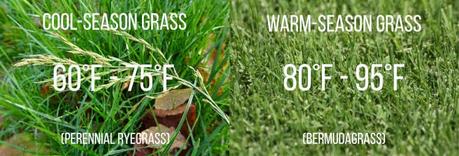Beautiful, lush green grass is an essential part of any appealing yard. Although growing grass might seem like the easiest of all gardening tasks, it can be a real challenge.
How long it’ll take for the grass seed to grow and whether it’ll germinate successfully depends on several factors.
In this article, we’ll dig deeper into each of them separately to provide you with all the info needed to ensure successful germination and establishment of grass seed.
Factors that Determine the Speed of Grass Growth
The following directly affect the speed of grass growth. Some of them you do not have control over, but two (or three) of them allow you to set the pace.
- type of grass seeds you’re sowing
- weather
- soil
- aftercare.
Types of Grass

The soil and weather conditions affect each type of grass seeds differently. However, there’s no region where the temperatures are that consistent. For this reason, the grass can be either cool-season or warm-season.
- Cool-season grass species are those with optimum growth at temperatures between 60 and 75°F. This group includes creeping bentgrass, fine fescue, tall fescue, Kentucky bluegrass, annual ryegrass, and perennial ryegrass.
- Warm-season grass species perform best at temperatures between 80 and 95°F. Bahiagrass, bermudagrass, carpetgrass, St. Augustine, and zoysiagrass fall into this group.
Hence, to speed up germination, sow the grass seeds at the right temperatures.
What is Germination?
Germination is the sprouting of a seedling from a seed. In general, it takes between 5 and 30 days for the seedlings to poke their way through the soil. After germination, it might take up to four weeks for the grass to reach mowable length. But then again, it all depends on the growing environment and the grass species.
Time Required for Grass Seed to Grow
In the following table, take a look at the germination time under perfect conditions of each turf species separately. Next to it, you can see the total estimated time required for each type of grass seed to grow.
(days)Total time for Grass to Grow
(days)
Annual Ryegrass
5 - 1033 - 38
Bermudagrass
10 - 3038 - 58
Buffalograss14 - 3042 - 58
Colonial Bentgrass
10 - 1438 - 42
Creeping Bentgrass
10 - 1438 - 42
Hard Fescue
7 - 1435 - 42
Kentucky Bluegrass14 - 3042 - 58
Perennial Ryegrass5 - 1033 - 38
Red Fescue7 - 1435 - 42
Rough Bluegrass7 - 1035 - 38
Tall Fescue7 - 1235 - 40
Season and Weather
The season you sow the grass seeds is another factor that determines the germination time. Sunshine is essential for the growth of almost any plant, but still, too much of it can prevent its ability to germinate. Therefore, sowing the grass seeds at the right temperature is crucial for the best outcome.
Cold temperatures inhibit growth, therefore, regardless of the grass type, avoid planting in winter since the seeds simply won’t germinate. Sowing in cold spring will delay the germination for a couple of weeks, which will expose the seeds at risk of being eaten by birds or blown away. Hot summer temperatures and dry soil, on the other hand, will hinder seed growth as well.
Therefore, the best time of the year to lay down the grass seeds is when the soil temperature is at least 50 degrees Fahrenheit – that is, mid-late spring and early fall.
Soil and Water Requirements

The moisture of the soil is as important as its temperature for seeds to germinate. But, more doesn’t always mean better. Bear in mind that the grass seeds prefer moist but not soggy environments. Keeping them waterlogged will result in fungal growth on the seeds, because of which they’ll rot. If the soil is dry, on the other hand, the seeds will lose the absorbed water and will die, too.
Furthermore, not all the seeds will sprout at the same time. For instance, not all of them will be buried at the same depth, so they’ll absorb water differently. Besides, not all of them will be of the same quality or maturity. Therefore, make sure to keep the soil moist at all times during the germination time.
Also, different soils have different pH levels, which will affect the seed germination differently, too. That is to say, some grass seeds need acidic soil to grow, while others prefer alkaline.
What to Do if Grass Seed Doesn’t Grow?
Ever happened to you to sow grass seeds, which won’t germinate at all? There must be a reason for that, and it’s some of the following:
Lack of Sunlight or a Shaded environment
So as the plant grows, it needs sunlight, no matter full or partial. If it doesn’t grow well or at all, most commonly, it’s because it lacks sunlight. Matured trees, privacy hedges, and even nearby buildings can provide too much shade to the turf, which will affect its growth. However, there’s a wide variety of grass types, from sun-loving to shade-tolerant, so make sure to choose the right one for your yard to ensure good germination and establishment of grass seed.Compacted Soil
Plant roots need to breathe, and if planted in compacted soil, oxygen won’t be able to move through pores within the soil to reach them. Not tilling the soil with organic matter might be a reason for it being compacted. Nevertheless, when you have compacted soil, aerate it with a core aerator, so the oxygen finds its way to the roots.Grass vs Tree roots
The grass might not perform well when nearby trees as well. Trees and large shrubs will take more than their fair share of water and nutrients, which will result in weak turf. The grass will always lose in a competition against bigger plants. Hence, to prevent it from growing in such a poor environment, expand the bed line to at least the drip line of the shrub or tree.Lack of Airflow
Planting a privacy screen in a small backyard will restrict the airflow, which increases the chances for the grass to develop disease issues. It won’t be that easy to solve the problem since the plants were planted there for a purpose in the first place. In this case, you can either limb-up trees to allow for better airflow or put something else instead of grass in the turf area.FAQs
⌛How long does it take for grass seeds to grow?In general, it takes between 5 and 30 days for the grass to poke its way through the soil. The time required depends on several factors, part of which are under your control. You should be careful with the type of grass you sow, when you sow them and where.
🤔Can you put down too much grass seed?The grass seeds need their own space in the soil so the roots spread and develop properly. When you put down too much grass seed, they’ll start competing for water and nutrients, inhibiting each other’s growth.
🌿Do I need to cover grass seed?Covering the grass seeds will prevent them from drying out, which will ensure successful germination. However, so you don’t end up doing more harm than good, it’s necessary to cover them with the right material. That is to say, straw, compost, mulch, and polyethylene plastic are effective budget-friendly options.
💧How often do you water new grass seed?The top inch of the soil should always be moist, but not over-watered, during seed germination. At this early stage, the grass should be watered twice a day, or even more under dryer conditions. After the seeds have germinated, you can start with a regular watering schedule.

